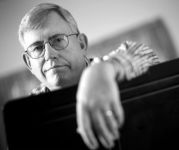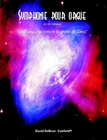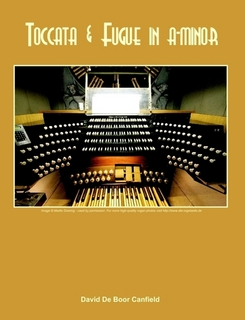 David DeBoor Canfield was born in Fort Lauderdale, Florida on September 23, 1950. Early musical studies were with his father, John Canfield. Initially, the younger Canfield pursued studies in chemistry, but switched midway through undergraduate studies to composition. After playing violin professionally in the Fort Lauderdale Symphony Orchestra and Miami Opera Association, he was accepted into Indiana University for graduate studies. His composition teachers there included John Eaton, Frederick Fox and Bernhard Heiden. He obtained the Master of Music degree from IU in 1977 and the Doctor of Music in 1983.
David DeBoor Canfield was born in Fort Lauderdale, Florida on September 23, 1950. Early musical studies were with his father, John Canfield. Initially, the younger Canfield pursued studies in chemistry, but switched midway through undergraduate studies to composition. After playing violin professionally in the Fort Lauderdale Symphony Orchestra and Miami Opera Association, he was accepted into Indiana University for graduate studies. His composition teachers there included John Eaton, Frederick Fox and Bernhard Heiden. He obtained the Master of Music degree from IU in 1977 and the Doctor of Music in 1983.
Symphonie pour orgue en re mineur


Price: $26.99 | Click to Order or Preview
The Symphonie pour orgue en re mineur is a product of David DeBoor Canfield’s student years at Indiana University, although he never showed the work to any of his composition teachers there. The reason for his reticence was that the work was cast in the unabashedly French romantic organ style of composers such as Vierne and Widor. During this period of Canfield’s life, he had been interested in organ building as a career, and had even taken a few organ lessons with Diane Bish, although Canfield today in no way considers himself an organist. Both Bish and Canfield were associated with the well-known Coral Ridge Presbyterian Church from the mid-1960s onward, and Canfield wrote this Symphonie at the console of the large Rufatti organ there. This explains the much longer period of its composition (1975-1978) than was required for most of his pieces, as he worked on it only during his infrequent visits back to his home town of Fort Lauderdale.
The Symphonie is cast in four movements, with a unifying motive consisting of an ascending arpeggio of D-F-A-D. The performer will note that even the key signatures of the four movements produce this same arpeggio. The opening Prelude was the last movement of the Symphonie to be composed, and also the shortest of its movements. Its purpose is primarily to set the tone for the rest of the work with a dramatic opening and closing, interspersed with more subdued sections. The second movement, Scherzo, was the first movement to be composed. Actually, it was originally intended as a stand-alone work, in tribute to Diane Bish’s organ piece, Joy. The similarity in spirit between the Bish work and this movement of the Symphonie will be readily noted, and in fact Canfield had originally entitled this movement Ecstasy, a further homage to Bish. After completing that movement, the idea of creating an entire Symphonie began to take place in Canfield’s mind, and he began work on the third movement, Sicilienne. This movement features staccato figurations thrown back and forth between manuals and pedals, with very typical French harmonies. The Symphonie concludes with a vigorous and virtuosic Final, intended to show off the skills of the organist and bring the work to a powerful conclusion, complete with trompettes en chamade.
After its completion, Canfield obtained the assistance of Diane Bish in registrating the work, but thereafter put it in a drawer for the next several decades, resurrecting it only when its existence became known to organ symphony specialist, Jonathan Orwig. The subtitle of the Symphonie, (Les cieux racontent la gloire de Dieu), the opening verse of Psalm 19, was added by the composer some years after the completion of the work. The majestic spirit of the music seemed appropriately linked to the majesty of creation to the composer.
Toccata and Fugue in A-minor
 Price: $13.99 | Click to Order or Preview
Price: $13.99 | Click to Order or Preview